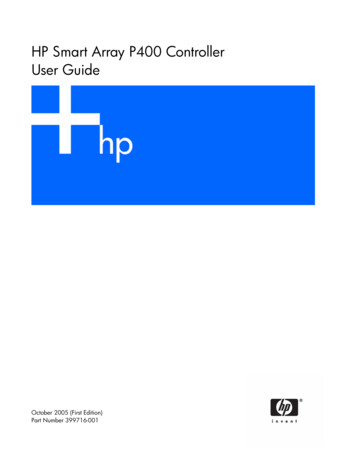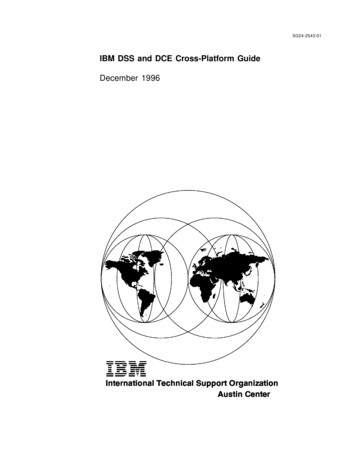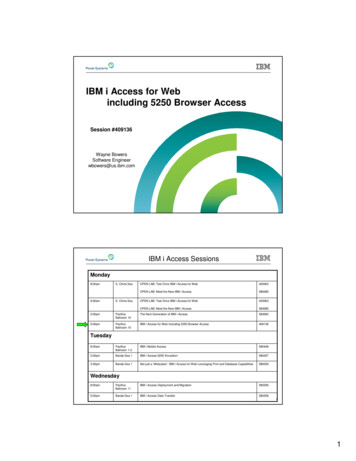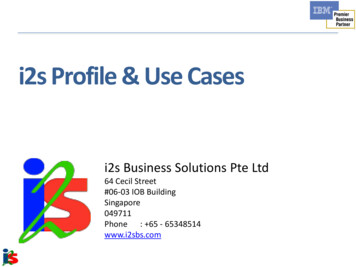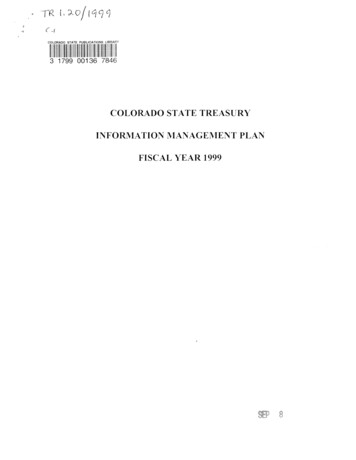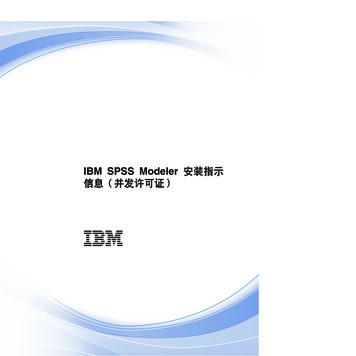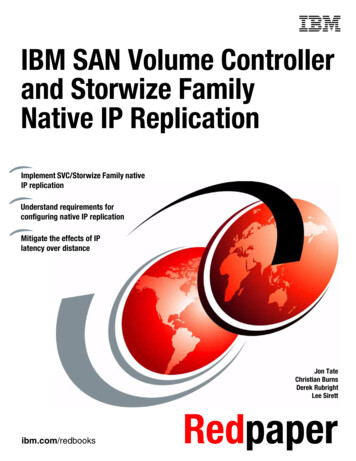
Transcription
Front coverIBM SAN Volume Controllerand Storwize FamilyNative IP ReplicationImplement SVC/Storwize Family nativeIP replicationUnderstand requirements forconfiguring native IP replicationMitigate the effects of IPlatency over distanceJon TateChristian BurnsDerek RubrightLee Sirettibm.com/redbooksRedpaper
International Technical Support OrganizationIBM SAN Volume Controller and Storwize FamilyNative IP ReplicationSeptember 2014REDP-5103-00
Note: Before using this information and the product it supports, read the information in “Notices” onpage vii.First Edition (September 2014)This edition applies to version 7.2 and above of IBM SAN Volume Controller and Storwize V7000, StorwizeV5000, and Storwize V3700. Copyright International Business Machines Corporation 2014. All rights reserved.Note to U.S. Government Users Restricted Rights -- Use, duplication or disclosure restricted by GSA ADP ScheduleContract with IBM Corp.
ContentsNotices . . . . . . . . . . . . . . . . . . . . . . . . . . . . . . . . . . . . . . . . . . . . . . . . . . . . . . . . . . . . . . . . . viiTrademarks . . . . . . . . . . . . . . . . . . . . . . . . . . . . . . . . . . . . . . . . . . . . . . . . . . . . . . . . . . . . . viiiPreface . . . . . . . . . . . . . . . . . . . . . . . . . . . . . . . . . . . . . . . . . . . . . . . . . . . . . . . . . . . . . . . . . ixAuthors . . . . . . . . . . . . . . . . . . . . . . . . . . . . . . . . . . . . . . . . . . . . . . . . . . . . . . . . . . . . . . . . . . ixNow you can become a published author, too! . . . . . . . . . . . . . . . . . . . . . . . . . . . . . . . . . . . .xComments welcome. . . . . . . . . . . . . . . . . . . . . . . . . . . . . . . . . . . . . . . . . . . . . . . . . . . . . . . . xiStay connected to IBM Redbooks . . . . . . . . . . . . . . . . . . . . . . . . . . . . . . . . . . . . . . . . . . . . . xiChapter 1. Introduction to native IP replication in SVC/Storwize . . . . . . . . . . . . . . . . . . 11.1 IP replication overview . . . . . . . . . . . . . . . . . . . . . . . . . . . . . . . . . . . . . . . . . . . . . . . . . . 21.2 Metro Mirror and Global Mirror overview. . . . . . . . . . . . . . . . . . . . . . . . . . . . . . . . . . . . . 21.2.1 Metro Mirror . . . . . . . . . . . . . . . . . . . . . . . . . . . . . . . . . . . . . . . . . . . . . . . . . . . . . . 21.2.2 Global Mirror . . . . . . . . . . . . . . . . . . . . . . . . . . . . . . . . . . . . . . . . . . . . . . . . . . . . . . 31.2.3 Global Mirror with Change Volumes . . . . . . . . . . . . . . . . . . . . . . . . . . . . . . . . . . . . 41.3 Example scenarios . . . . . . . . . . . . . . . . . . . . . . . . . . . . . . . . . . . . . . . . . . . . . . . . . . . . . 41.3.1 Single WAN link to a single input/output group . . . . . . . . . . . . . . . . . . . . . . . . . . . . 51.3.2 Single WAN link to dual I/O groups. . . . . . . . . . . . . . . . . . . . . . . . . . . . . . . . . . . . . 51.3.3 Dual WAN links to a single I/O group . . . . . . . . . . . . . . . . . . . . . . . . . . . . . . . . . . . 61.3.4 Dual WAN links to dual I/O groups . . . . . . . . . . . . . . . . . . . . . . . . . . . . . . . . . . . . . 71.4 SVC/Storwize IP replication in more detail . . . . . . . . . . . . . . . . . . . . . . . . . . . . . . . . . . . 71.4.1 Performance degradation with TCP/IP . . . . . . . . . . . . . . . . . . . . . . . . . . . . . . . . . . 71.4.2 How SVC/Storwize improves performance . . . . . . . . . . . . . . . . . . . . . . . . . . . . . . . 81.4.3 Performance benefit . . . . . . . . . . . . . . . . . . . . . . . . . . . . . . . . . . . . . . . . . . . . . . . 10Chapter 2. IP replication configuration overview and considerations. . . . . . . . . . . . .2.1 IP partnerships . . . . . . . . . . . . . . . . . . . . . . . . . . . . . . . . . . . . . . . . . . . . . . . . . . . . . . .2.1.1 Intersite link planning . . . . . . . . . . . . . . . . . . . . . . . . . . . . . . . . . . . . . . . . . . . . . .2.1.2 IP partnership requirements . . . . . . . . . . . . . . . . . . . . . . . . . . . . . . . . . . . . . . . . .2.1.3 Configuring IP partnerships . . . . . . . . . . . . . . . . . . . . . . . . . . . . . . . . . . . . . . . . .2.1.4 Remote-copy port groups . . . . . . . . . . . . . . . . . . . . . . . . . . . . . . . . . . . . . . . . . . .2.1.5 Node port status . . . . . . . . . . . . . . . . . . . . . . . . . . . . . . . . . . . . . . . . . . . . . . . . . .2.1.6 IP replication link failover . . . . . . . . . . . . . . . . . . . . . . . . . . . . . . . . . . . . . . . . . . .2.1.7 Using CHAP with IP partnerships . . . . . . . . . . . . . . . . . . . . . . . . . . . . . . . . . . . . .2.2 Setting up remote copy relationships on SVC/Storwize . . . . . . . . . . . . . . . . . . . . . . . .2.3 Migrating between FC and IP replication . . . . . . . . . . . . . . . . . . . . . . . . . . . . . . . . . . .2.3.1 Migration between FC and IP, or IP and FC . . . . . . . . . . . . . . . . . . . . . . . . . . . . .2.3.2 Migration between IPv4 and IPv6, or IPv6 and IPv4. . . . . . . . . . . . . . . . . . . . . . .2.3.3 Migration between 1 Gbps and 10 Gbps, or 10 Gbps and 1 Gbps . . . . . . . . . . . .1112121314151516161717171819Chapter 3. Implementing IP replication in the SVC/Storwize family. . . . . . . . . . . . . . .3.1 Configuring IP replication . . . . . . . . . . . . . . . . . . . . . . . . . . . . . . . . . . . . . . . . . . . . . . .3.1.1 Overview of required steps . . . . . . . . . . . . . . . . . . . . . . . . . . . . . . . . . . . . . . . . . .3.1.2 Physical details of an example environment . . . . . . . . . . . . . . . . . . . . . . . . . . . . .3.1.3 Configure the Ethernet ports on the partner systems . . . . . . . . . . . . . . . . . . . . . .3.1.4 Create and configure the IP partnership on each of the partner systems. . . . . . .3.1.5 Creating IP remote-copy consistency groups and relationships . . . . . . . . . . . . . .21222222242832 Copyright IBM Corp. 2014. All rights reserved.iii
ivChapter 4. Best practices and troubleshooting . . . . . . . . . . . . . . . . . . . . . . . . . . . . . . .4.1 Best practices . . . . . . . . . . . . . . . . . . . . . . . . . . . . . . . . . . . . . . . . . . . . . . . . . . . . . . . .4.1.1 System configuration . . . . . . . . . . . . . . . . . . . . . . . . . . . . . . . . . . . . . . . . . . . . . .4.1.2 Performance considerations . . . . . . . . . . . . . . . . . . . . . . . . . . . . . . . . . . . . . . . . .4.2 Implementation and usage troubleshooting . . . . . . . . . . . . . . . . . . . . . . . . . . . . . . . . .4.2.1 Error code CMMVC8359E . . . . . . . . . . . . . . . . . . . . . . . . . . . . . . . . . . . . . . . . . .4.2.2 Error code CMMVC8354E . . . . . . . . . . . . . . . . . . . . . . . . . . . . . . . . . . . . . . . . . .4.2.3 Error Code CMMVC8353E . . . . . . . . . . . . . . . . . . . . . . . . . . . . . . . . . . . . . . . . . .4.2.4 Error Code 2020 . . . . . . . . . . . . . . . . . . . . . . . . . . . . . . . . . . . . . . . . . . . . . . . . . .4.2.5 Error Code 2021 . . . . . . . . . . . . . . . . . . . . . . . . . . . . . . . . . . . . . . . . . . . . . . . . . .4.2.6 Error Code 2022 . . . . . . . . . . . . . . . . . . . . . . . . . . . . . . . . . . . . . . . . . . . . . . . . . .4.2.7 Error Code 2023 . . . . . . . . . . . . . . . . . . . . . . . . . . . . . . . . . . . . . . . . . . . . . . . . . .454646464747484949505152Appendix A. Command-line interface . . . . . . . . . . . . . . . . . . . . . . . . . . . . . . . . . . . . . . .Configuring Ethernet ports on the partner systems . . . . . . . . . . . . . . . . . . . . . . . . . . . . . . .Create and configure the IP partnership on each of the partner systems. . . . . . . . . . . .Creating IP remote-copy consistency groups and relationships . . . . . . . . . . . . . . . . . . .Starting the IP remote-copy consistency group . . . . . . . . . . . . . . . . . . . . . . . . . . . . . . .5354555556Appendix B. CHAP Information and Implementation . . . . . . . . . . . . . . . . . . . . . . . . . .General information on CHAP . . . . . . . . . . . . . . . . . . . . . . . . . . . . . . . . . . . . . . . . . . . . . . .Configuring CHAP for IP replication . . . . . . . . . . . . . . . . . . . . . . . . . . . . . . . . . . . . . . . . . . .Configure system-wide CHAP secret . . . . . . . . . . . . . . . . . . . . . . . . . . . . . . . . . . . . . . .Configure partnership to use the CHAP secret . . . . . . . . . . . . . . . . . . . . . . . . . . . . . . . .5758585859Related publications . . . . . . . . . . . . . . . . . . . . . . . . . . . . . . . . . . . . . . . . . . . . . . . . . . . . .IBM Redbooks . . . . . . . . . . . . . . . . . . . . . . . . . . . . . . . . . . . . . . . . . . . . . . . . . . . . . . . . . . .Other publications . . . . . . . . . . . . . . . . . . . . . . . . . . . . . . . . . . . . . . . . . . . . . . . . . . . . . . . .Online resources . . . . . . . . . . . . . . . . . . . . . . . . . . . . . . . . . . . . . . . . . . . . . . . . . . . . . . . . .How to get IBM Redbooks . . . . . . . . . . . . . . . . . . . . . . . . . . . . . . . . . . . . . . . . . . . . . . . . . .Help from IBM . . . . . . . . . . . . . . . . . . . . . . . . . . . . . . . . . . . . . . . . . . . . . . . . . . . . . . . . . . .616161616161IBM SAN Volume Controller and Storwize Family Native IP Replication
NoticesThis information was developed for products and services offered in the U.S.A.IBM may not offer the products, services, or features discussed in this document in other countries. Consultyour local IBM representative for information on the products and services currently available in your area. Anyreference to an IBM product, program, or service is not intended to state or imply that only that IBM product,program, or service may be used. Any functionally equivalent product, program, or service that does notinfringe any IBM intellectual property right may be used instead. However, it is the user's responsibility toevaluate and verify the operation of any non-IBM product, program, or service.IBM may have patents or pending patent applications covering subject matter described in this document. Thefurnishing of this document does not grant you any license to these patents. You can send license inquiries, inwriting, to:IBM Director of Licensing, IBM Corporation, North Castle Drive, Armonk, NY 10504-1785 U.S.A.The following paragraph does not apply to the United Kingdom or any other country where suchprovisions are inconsistent with local law: INTERNATIONAL BUSINESS MACHINES CORPORATIONPROVIDES THIS PUBLICATION “AS IS” WITHOUT WARRANTY OF ANY KIND, EITHER EXPRESS ORIMPLIED, INCLUDING, BUT NOT LIMITED TO, THE IMPLIED WARRANTIES OF NON-INFRINGEMENT,MERCHANTABILITY OR FITNESS FOR A PARTICULAR PURPOSE. Some states do not allow disclaimer ofexpress or implied warranties in certain transactions, therefore, this statement may not apply to you.This information could include technical inaccuracies or typographical errors. Changes are periodically madeto the information herein; these changes will be incorporated in new editions of the publication. IBM may makeimprovements and/or changes in the product(s) and/or the program(s) described in this publication at any timewithout notice.Any references in this information to non-IBM websites are provided for convenience only and do not in anymanner serve as an endorsement of those websites. The materials at those websites are not part of thematerials for this IBM product and use of those websites is at your own risk.IBM may use or distribute any of the information you supply in any way it believes appropriate without incurringany obligation to you.Any performance data contained herein was determined in a controlled environment. Therefore, the resultsobtained in other operating environments may vary significantly. Some measurements may have been madeon development-level systems and there is no guarantee that these measurements will be the same ongenerally available systems. Furthermore, some measurements may have been estimated throughextrapolation. Actual results may vary. Users of this document should verify the applicable data for theirspecific environment.Information concerning non-IBM products was obtained from the suppliers of those products, their publishedannouncements or other publicly available sources. IBM has not tested those products and cannot confirm theaccuracy of performance, compatibility or any other claims related to non-IBM products. Questions on thecapabilities of non-IBM products should be addressed to the suppliers of those products.This information contains examples of data and reports used in daily business operations. To illustrate themas completely as possible, the examples include the names of individuals, companies, brands, and products.All of these names are fictitious and any similarity to the names and addresses used by an actual businessenterprise is entirely coincidental.COPYRIGHT LICENSE:This information contains sample application programs in source language, which illustrate programmingtechniques on various operating platforms. You may copy, modify, and distribute these sample programs inany form without payment to IBM, for the purposes of developing, using, marketing or distributing applicationprograms conforming to the application programming interface for the operating platform for which the sampleprograms are written. These examples have not been thoroughly tested under all conditions. IBM, therefore,cannot guarantee or imply reliability, serviceability, or function of these programs. Copyright IBM Corp. 2014. All rights reserved.vii
TrademarksIBM, the IBM logo, and ibm.com are trademarks or registered trademarks of International Business MachinesCorporation in the United States, other countries, or both. These and other IBM trademarked terms aremarked on their first occurrence in this information with the appropriate symbol ( or ), indicating USregistered or common law trademarks owned by IBM at the time this information was published. Suchtrademarks may also be registered or common law trademarks in other countries. A current list of IBMtrademarks is available on the Web at http://www.ibm.com/legal/copytrade.shtmlThe following terms are trademarks of the International Business Machines Corporation in the United States,other countries, or both:DB2 FlashCopy FlashSystem IBM IBM FlashSystem Power Systems Real-time Compression Redbooks Redpaper Redbooks (logo) Storwize System Storage XIV The following terms are trademarks of other companies:Other company, product, or service names may be trademarks or service marks of others.viiiIBM SAN Volume Controller and Storwize Family Native IP Replication
PrefaceIBM has announced native Internet Protocol (IP) replication using Bridgeworks SANSlidetechnology with its IBM System Storage SAN Volume Controller (SVC), IBM Storwize V7000, IBM Storwize V5000 and Storwize V3700 virtualized storage systems.This combination of SANSlide and the SVC/Storwize family provides a powerful solution forclients who require efficient, IP-based replication over long distances.This certification gives SVC/Storwize clients a fully supported, transparent technology thatincludes unmatched levels of performance and reliability. With the SANSlide protocolacceleration technology, it is now possible to replicate data across continents in acost-efficient way, with little or no loss in performance. At the same time, bandwidth usagecan improve to over 95%, rather than the 1% - 5% normally achieved in long-distance IPnetworks.This IBM Redpaper publication shows the steps required to implement this solutionefficiently and speedily.AuthorsThis paper was produced by a team of specialists from around the world working at theInternational Technical Support Organization (ITSO), Hursley Lab, UK.Jon Tate is a Project Manager for IBM System Storage SANSolutions at the ITSO, San Jose Center. Before joining theITSO in 1999, he worked in the IBM Technical Support Center,providing Level 2 support for IBM storage products. Jon has 28years of experience in storage software and management,services, and support, and is both an IBM Certified ITSpecialist and an IBM SAN Certified Specialist. He is also theUK Chairman of the Storage Networking Industry Association.Christian Burns is an IBM Storage Solution Architect based inNew Jersey. As a member of the Storage SolutionsEngineering team in Littleton, MA, he works with clients,IBM Business Partners, and IBMers worldwide, designing andimplementing storage solutions that include various IBMproducts and technologies. Christian’s areas of expertiseinclude IBM Real-time Compression , SVC, IBM XIV , andIBM FlashSystem . Before joining IBM, Christian was theDirector of Sales Engineering at IBM Storwize, before itbecame IBM Storwize. He brings over a decade of industryexperience in the areas of sales engineering, solution design,and software development. Christian holds a BA degree inPhysics and Computer Science from Rutgers College. Copyright IBM Corp. 2014. All rights reserved.ix
Derek Rubright is a Staff Software Engineer, specializing inIBM SAN Volume Controller and Storwize V7000, at ResearchTriangle Park in Raleigh, NC. He has over 15 years ofexperience in technical customer support, and 5 years ofexperience in storage and storage area network (SAN)environments.Lee Sirett is a Storage Technical Advisor for the EuropeanStorage Competency Centre (ESCC) in Mainz, Germany.Before joining the ESCC, he worked in IBM Technical SupportServices for 10 years providing support on a range of IBMProducts, including IBM Power Systems . Lee has 24 years ofexperience in the IT Industry. He is IBM Storage Certified, andboth an IBM Certified XIV Administrator and Certified XIVSpecialist.Thanks to the following people for their contributions to this project:Bill PassinghamAndrew MartinAndrea SipkaMatt SmithIBM HursleyNow you can become a published author, too!Here’s an opportunity to spotlight your skills, grow your career, and become a publishedauthor—all at the same time! Join an ITSO residency project and help write a book in yourarea of expertise, while honing your experience using leading-edge technologies.Your efforts will help to increase product acceptance and customer satisfaction, as youexpand your network of technical contacts and relationships. Residencies run from two to sixweeks in length, and you can participate either in person or as a remote resident workingfrom your home base.Obtain more information about the residency program, browse the residency index, and applyonline:ibm.com/redbooks/residencies.htmlxIBM SAN Volume Controller and Storwize Family Native IP Replication
Comments welcomeYour comments are important to us!We want our papers to be as helpful as possible. Send us your comments about this paper orother IBM Redbooks publications in one of the following ways: Use the online Contact us review Redbooks form:ibm.com/redbooks Send your comments in an email:redbooks@us.ibm.com Mail your comments:IBM Corporation, International Technical Support OrganizationDept. HYTD Mail Station P0992455 South RoadPoughkeepsie, NY 12601-5400Stay connected to IBM Redbooks Find us on Facebook:http://www.facebook.com/IBMRedbooks Follow us on Twitter:http://twitter.com/ibmredbooks Look for us on LinkedIn:http://www.linkedin.com/groups?home &gid 2130806 Explore new Redbooks publications, residencies, and workshops with the IBM Redbooksweekly sf/subscribe?OpenForm Stay current on recent Redbooks publications with RSS i
xiiIBM SAN Volume Controller and Storwize Family Native IP Replication
1Chapter 1.Introduction to native IPreplication in SVC/StorwizeThis chapter describes the new functionality introduced with code version 7.2, which supportsnative IP replication across the IBM Storwize family, including IBM System Storage SANVolume Controller (SVC). The functionality of the new feature is covered, along with asummary of the SVC/Storwize remote mirror technologies.Important: Although this paper provides information about the Storwize V7000 and SVC, italso applies to the Storwize V5000 and the Storwize V3700. Copyright IBM Corp. 2014. All rights reserved.1
1.1 IP replication overviewThe native Internet Protocol (IP) replication feature enables replication between anySVC/Storwize family member running code version 7.2 or higher, using the built-in networkingports of the cluster nodes. Following a recent partnership with IBM, it uses SANslidetechnology developed by Bridgeworks Limited of Christchurch, UK. They specialize inproducts that can bridge storage protocols and accelerate data transfer over long distances.Adding this technology at each end of a wide area network (WAN) Transmission ControlProtocol/Internet Protocol (TCP/IP) link significantly improves the usage of the link. It doesthis by applying patented Artificial Intelligence (AI) to hide latency normally associated withWANs. Therefore, doing so can greatly improve the performance of mirroring services, inparticular Global Mirror with Change Volumes (GM/CV) over long distances.More details are provided in 1.4, “SVC/Storwize IP replication in more detail” on page 7.Tip: Although all versions of 7.2 code offer native IP replication, versions 7.2.0.4 and lateroffer performance enhancements to the SANslide technology.1.2 Metro Mirror and Global Mirror overviewMetro Mirror (MM) and Global Mirror (GM) are technologies that enable you to keep a realtime, or near real-time, copy of a disk at a remote site that contains another SVC cluster orStorwize V7000 system.1.2.1 Metro MirrorMM makes synchronous copies, which means that the original writes are not consideredcomplete until the write to the destination disk has been confirmed. The distance between twosites is usually determined by how much latency the applications can handle. Therefore, MMis typically used within metropolitan distances in conjunction with a zero recovery pointobjective (RPO), that is, zero data loss.2IBM SAN Volume Controller and Storwize Family Native IP Replication
Figure 1-1 shows the order of MM write operations.Figure 1-1 Metro Mirror write sequence1.2.2 Global MirrorGM makes asynchronous copies of your disk. This means that the write is consideredcomplete after it is complete at the local disk; it does not wait for the write to be confirmed atthe remote cluster like MM does. This greatly reduces the latency experienced by applicationsif the other cluster is far away. However, it also means that, during a failure, the data on theremote copy might not have the most recent changes committed to the local disk.Figure 1-2 shows the order of GM write operations.Figure 1-2 Global Mirror write sequenceChapter 1. Introduction to native IP replication in SVC/Storwize3
1.2.3 Global Mirror with Change VolumesThis function (also known as Cycle-Mode Global Mirror), was introduced in Storwize V7000V6.3, and can best be described as Continuous Remote IBM FlashCopy . If you use thisfeature, the Storwize V7000 will essentially take periodic flash copies of a disk, and writethem to your remote destination.This feature completely isolates the local copy from WAN issues, such as line glitches, andfrom sudden spikes in workload that might occur. Bear in mind that your remote copy mightlag behind the original, depending on how you have set up the cycle time.Figure 1-3 shows a high-level conceptual view of GM/CV. GM/CV uses FlashCopy to maintainimage consistency, and to isolate host volumes from the replication process.Figure 1-3 Global Mirror with Change VolumesInformation: For more information about SVC and Storwize V7000 replication, see IBMSystem Storage SAN Volume Controller and Storwize V7000 Replication Family Services,SG24-7574.For more information about the SVC, see Implementing the IBM System Storage SANVolume Controller V7.2, SG24-7933.For more information about the Storwize V7000, see Implementing the IBM StorwizeV7000 V7.2, SG24-7938.For more information about the Storwize V5000, see Implementing the IBM StorwizeV5000, SG24-8162For more information about the Storwize V3700, see Implementing the IBM StorwizeV3700, SG24-81071.3 Example scenariosA SVC/Storwize cluster in one location can be connected to another SVC/Storwize cluster ata remote location using various designs. The following sections show example connectivitydesigns.4IBM SAN Volume Controller and Storwize Family Native IP Replication
1.3.1 Single WAN link to a single input/output groupFigure 1-4 shows a single WAN link connecting two Storwize V7000 clusters consisting of asingle input/output (I/O) group each. In this design, there is a redundant connection from eachStorwize V7000. Either Ethernet port 1 or 2 can be configured for IP replication, but not both.This protects against a node connection failure or a node canister outage (for example, for acode upgrade). However, it does not protect against a WAN connection failure.Figure 1-4 Single WAN link to a single I/O groupIn this scenario, the remote-copy port group on each system includes two IP addresses, onefrom each node. When the system initially configures, one of these IP addresses is chosenfrom each side. This pairing cannot be chosen or changed by an administrator. In theprevious example, H1 and M2 have established a connection. If M2 fails, the session will belost but the connection will automatically be re-established between either H1 or H2 and M1.The IP addresses do not fail over between nodes for the purposes of IP replication. Althoughthe address does in fact move to the other node, as can be seen from the output of thelsportip command when a node does fail, this is for Internet Small Computer SystemInterface (iSCSI) purposes only. The IP replication link will be re-established with thepreviously assigned original IP address of the port.1.3.2 Single WAN link to dual I/O groupsFigure 1-5 on page 6 shows a single WAN link connecting two Storwize V7000 clustersconsisting of dual I/O groups. This design also provides redundancy against a node failure,but not against a WAN failure. The remote-copy port group on each system has four IPaddresses, one from each node.When the system initially configures, one of these IP addresses is chosen from each side.This pairing cannot be chosen or changed by an administrator. If one of the paired nodesfails, for example H1, then the connection will be lost as before, but re-established betweeneither H2, H3, or H4 and M1, M2, M3, or M4.Restriction: Storwize V7000 and SVC nodes with more than two I/O groups aresupported. However, there is a limitation that only four IP addresses, from two I/O groupsper system, can be included in a remote-copy port group. If there is only one intersite linkthere must be only one port group.Chapter 1. Introduction to native IP replication in SVC/Storwize5
Figure 1-5 shows a single WAN link connecting two Storwize V7000 clusters.Figure 1-5 Dual I/O group with a single WAN link1.3.3 Dual WAN links to a single I/O groupThe design shown in Figure 1-6 shows a dual redundant WAN link connecting two StorwizeV7000 clusters consisting of a single I/O group each. In this design, port group 1 and 2 havetwo IP addresses, each on a different node in a different system. This design enables twosimultaneous IP replication sessions; however, there is only one active port per node. If anynode should fail, the associated connection would also fail with the loss of half the bandwidth.Figure 1-6 Dual WAN links to a single I/O group6IBM SAN Volume Controller and Storwize Family Native IP Replication
1.3.4 Dual WAN links to dual I/O groupsIf the required bandwidth means that there must be dual links, then a failure of one might leadto an effect on MM or GM if there is no redundancy at the node canister level. In this case, theadvice would be to have two I/O groups at each site to enable recovery from any single nodefailure or outage, as shown in Figure 1-7.Figure 1-7 Dual WAN links to dual I/O groups1.4 SVC/Storwize IP replication in more detailThe introduction of native IP replication provides an alternative to the traditional use of a pairof Fibre Channel over IP (FCIP) routers, or wave division multiplexors (WDMs) for WANconnectivity and to native Fibre Channel (FC) connectivity. Before the release of the version7.2 code, if there was a need for replication, the only option was FC connectivity.FC technology uses the concept of buffer-to-buffer (B2B) credits as a flow control method tomaximize the performance of an individual link. The B2B credits are calculated depending onthe speed and the distance of the link, and represent the number of frames a port can store.The faster the link, the more frames can be in flight, and the higher the B2B credit. TraditionalIP does not have this concept.1.4.1 Performance degradation with TCP/IPPut simply, with TCP/IP, information transfer slows the farther you go. This is because of thelatency caused by waiting for acknowledgment of each set of packets sent, because the nextpacket set cannot be sent until the previous one has been acknowledged:Latency Round Trip Time (RTT) for a single packet setChapter 1. Introduction to native IP replication in SVC/Storwize7
Figure 1-8 illustrates this packet flow for a typical IP link.Figure 1-8 Link usage on a standard IP linkFigure 1-9 shows how throughput drops off as latency increases.Figure 1-9 Effect of latency on performance1.4.2 How SVC/Storwize improves performanceThe technology built into the SVC/Storwize code uses TCP/IP latency to its advantage.Rather than wait for the acknowledgment to come back, it sends more sets of packets acrossother virtual connections. The number of virtual connections is controlled by the AI engine.This improves WAN connection use, which results in a da
V7000, IBM Storwize V5000 and Storwize V3700 virtualized storage systems. This combination of SANSlide and the SVC/Storwize family provides a powerful solution for clients who require efficient, IP-based replication over long distances. This certification gives SVC/Storwize clients a fully supported, transparent technology that




